
The Vale of Glamorgan, often referred to as The Vale, is a county borough in the south-east of Wales. It borders Bridgend County Borough to the west, Cardiff to the east, Rhondda Cynon Taf to the north, and the Bristol Channel to the south. With an economy based largely on agriculture and chemicals, it is the southernmost unitary authority in Wales. Attractions include Barry Island Pleasure Park, the Barry Tourist Railway, Medieval wall paintings in St Cadoc's Church, Llancarfan, Porthkerry Park, St Donat's Castle, Cosmeston Lakes Country Park and Cosmeston Medieval Village. The largest town is Barry. Other towns include Penarth, Llantwit Major, and Cowbridge. There are many villages in the county borough.

Cowbridge is a market town in the Vale of Glamorgan, Wales, approximately 12 miles (19 km) west of the centre of Cardiff.

Llantwit Major is a town and community in Wales on the Bristol Channel coast. It is one of four towns in the Vale of Glamorgan, with the third largest population after Barry and Penarth, and ahead of Cowbridge. It is 4+1⁄2 miles (7.2 km) from Cowbridge, 9 miles (14 km) from Bridgend, 10 miles (16 km) from Barry, and 15 miles (24 km) from Cardiff. It had a population of 9,530 in 2021.

Colwinston is both a village and a community in the Vale of Glamorgan, Wales, approximately 4 miles (6.4 km) southeast of the centre of Bridgend and 21 miles (34 km) west of the centre of Cardiff. The village is located within 1⁄2 mile (0.80 km) of the A48. The population in 2005 was approximately 400 but with recent building development, the population is now estimated at over 600 people.
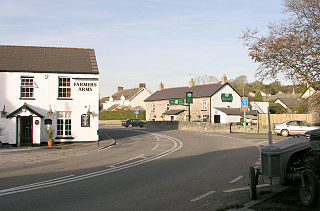
Aberthin is a small village, just outside Cowbridge in the Vale of Glamorgan, South Wales, on the north side of a shallow valley, less than a mile northeast of Cowbridge across the A48 road. Cowbridge Comprehensive School lies just to the southwest of the village. About 250 metres to the south is an old quarry, with a "faulted strip of grey oolite". Aberthin is also the name of a brook, the River Aberthin. The village was served by the Aberthin Platform railway station between 1905 and 1920, now a field to the west of Aberthin.

Francis Gwyn PC, of Llansannor Court, was a Welsh Tory politician who sat in the English and British Houses of Commons at various times between 1673 and 1727.

Flemingston is a small village in the Vale of Glamorgan in south Wales. It is located 8.5 miles (13.7 km) northwest by road from the town centre of Barry. It contains the Church of St. Michael the Archangel, the ruins of Flemingston Court, and Flemingston Manor or Grange, all of which are listed buildings. Historically, the parish of Flemingston was a sub-manor of Aberthaw or St Athan.
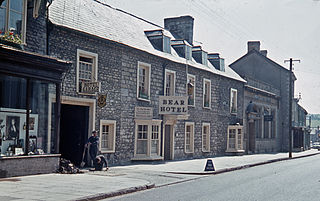
The Bear Inn, today known as The Bear Hotel, is an inn on Cowbridge High Street in Cowbridge, Vale of Glamorgan, south Wales. The block stone building has a blue plaque on the front, marking its historical significance. It became a Grade II listed building on 12 May 1963.
A bibliography of books related to the Vale of Glamorgan, south Wales.

There are 33 Grade I listed buildings in the Vale of Glamorgan all of which are churches and priory buildings, castles, country or manor houses and associated structures such as churchyard crosses and a dovecote.

St Mary Hill is a settlement in the Vale of Glamorgan, Wales. It is located approximately 4 miles (6.4 km) north west of the market town of Cowbridge. It is part of the community of Llangan along with Treoes and the village of Llangan itself.

St Georges super Ely, also known as St Georges, is a small village and community in the western outskirts of Cardiff, in the Vale of Glamorgan, South Wales. Lying to the northwest of Culverhouse Cross, between Peterston-super-Ely and Michaelston-super-Ely, it contains a medieval church and ruined manor house dated to the fifteenth century. The community includes the settlements of Drope, Downs and Sant-y-Nyll.

Frampton is a hamlet in the Vale of Glamorgan in South Wales. It lies within the parish of Llantwit Major, to the north of the town off the B4265 road, 4.25 miles (6.84 km) south-southwest of Cowbridge. It is divided into Little Frampton and Great Frampton.
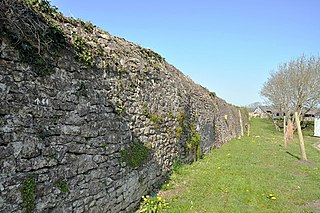
Cowbridge town wall is a Grade II*-listed medieval wall in the small market town of Cowbridge in the Vale of Glamorgan, south Wales. The walls were built by about 1300. It is believed that the purpose of the wall was to protect the Lord of Glamorgan's burgage plots and to provide a way of collecting tolls from the town's market, held twice-weekly. The wall has been altered several times throughout its existence.
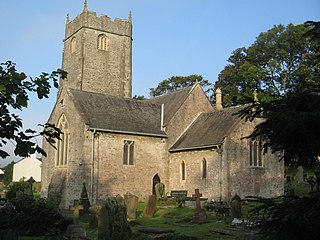
The Church of St John the Baptist is a medieval church in Llanblethian in the Vale of Glamorgan, south Wales. Believed to have been built in the 12th century, the church boasts an unusual tower, consistent with the style more common in the south west of England. It underwent extensive restoration in the late 19th century, undertaken by C. B. Fowler of Cardiff. The Church of St John was listed as a Grade I building on 22 February 1963.
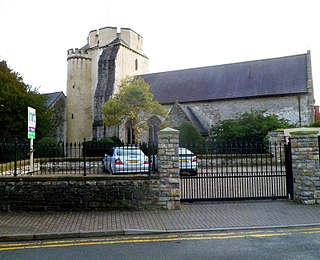
The Church of the Holy Cross is a medieval church in Cowbridge in the Vale of Glamorgan, south Wales. Initially a chapel of ease to Church of St John the Baptist, Llanblethian of Cowbridge as a medieval market town. Believed to have been built in the 13th century, the church has an unusual tower design. It has undergone several restorations including one by John Prichard in 1850–52. The Church of the Holy Cross was listed as a Grade I building on 12 May 1963.
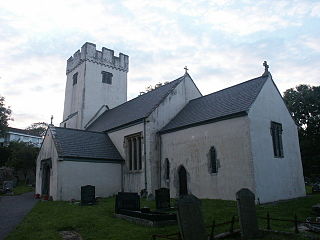
St Michael and All Angels Church is a Grade I listed church in Colwinston, in the Vale of Glamorgan, south Wales. It became a Grade I listed building on 22 February 1963. The church is said to have been built in 1111. The earliest mention of this parish church comes in the form of an 1141 confirmation of a donation made to the church by Maurice de Londres. The church and all of its possessions were given to the Abbey of Gloucester; this was confirmed circa 1200 when the Bishop of Landaff assigned a resident chaplain to the church. In 1254, the church was listed with a valuation of five marks. By 1291, it was combined with the valuation of Ewenny Priory.

St Senwyr's Church is a Grade I listed church in Llansannor, in the Vale of Glamorgan, south Wales. It became a Grade I listed building on 22 February 1963.

Edward Prideaux Gwyn (c.1698–1736) of Llansannor Court, Glamorgan. and Forde Abbey, Dorset was a British Tory politician who sat in the House of Commons from 1724 to 1729.

All Saints' Church, Oystermouth is an Anglican church in the Diocese of Swansea and Brecon, South Wales. It is located in Mumbles and is a Grade II listed building The church stands on a hillside, not far from Oystermouth Castle.



















